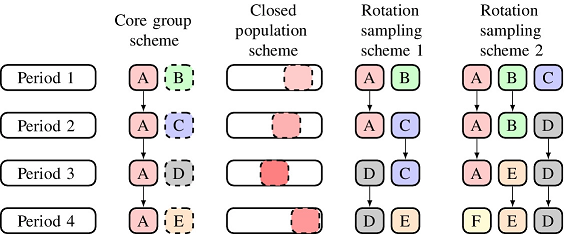Sample size and power calculations for open cohort longitudinal cluster randomized trials

In their latest paper, ViCBiostat Executive members Dr Jessica Kasza and Professor Andrew Forbes discuss different types of open cohort sampling schemes and how open cohort sampling structure impacts on power in the presence of decaying within‐cluster correlations and autoregressive participant‐level errors.
When calculating sample size or power for stepped wedge or other types of longitudinal cluster randomized trials, it is critical that the planned sampling structure be accurately specified. One common assumption is that participants will provide measurements in each trial period, that is, a closed cohort, and another is that each participant provides only one measurement during the course of the trial. However some studies have an “open cohort” sampling structure, where participants may provide measurements in variable numbers of periods.
To date, sample size calculations for longitudinal cluster randomized trials have not accommodated open cohorts. Feldman and McKinlay (1994) provided some guidance, stating that the participant‐level autocorrelation could be varied to account for the degree of overlap in different periods of the study, but did not indicate precisely how to do so. We present sample size and power formulas that allow for open cohorts and discuss the impact of the degree of “openness” on sample size and power. We consider designs where the number of participants in each cluster will be maintained throughout the trial, but individual participants may provide differing numbers of measurements. Our results are a unification of closed cohort and repeated cross‐sectional sample results of Hooper et al (2016), and indicate precisely how participant autocorrelation of Feldman and McKinlay should be varied to account for an open cohort sampling structure.
The full publication is available via this link.
The code for the R Shiny app is available online at https://github.com/jkasza/OpenCohort
Kasza J, Hooper R, Copas A, Forbes AB. Sample size and power calculations for open cohort longitudinal cluster randomized trials. Statistics in Medicine 39(13):1871-1883 2020. https://doi.org/10.1002/sim.8519


